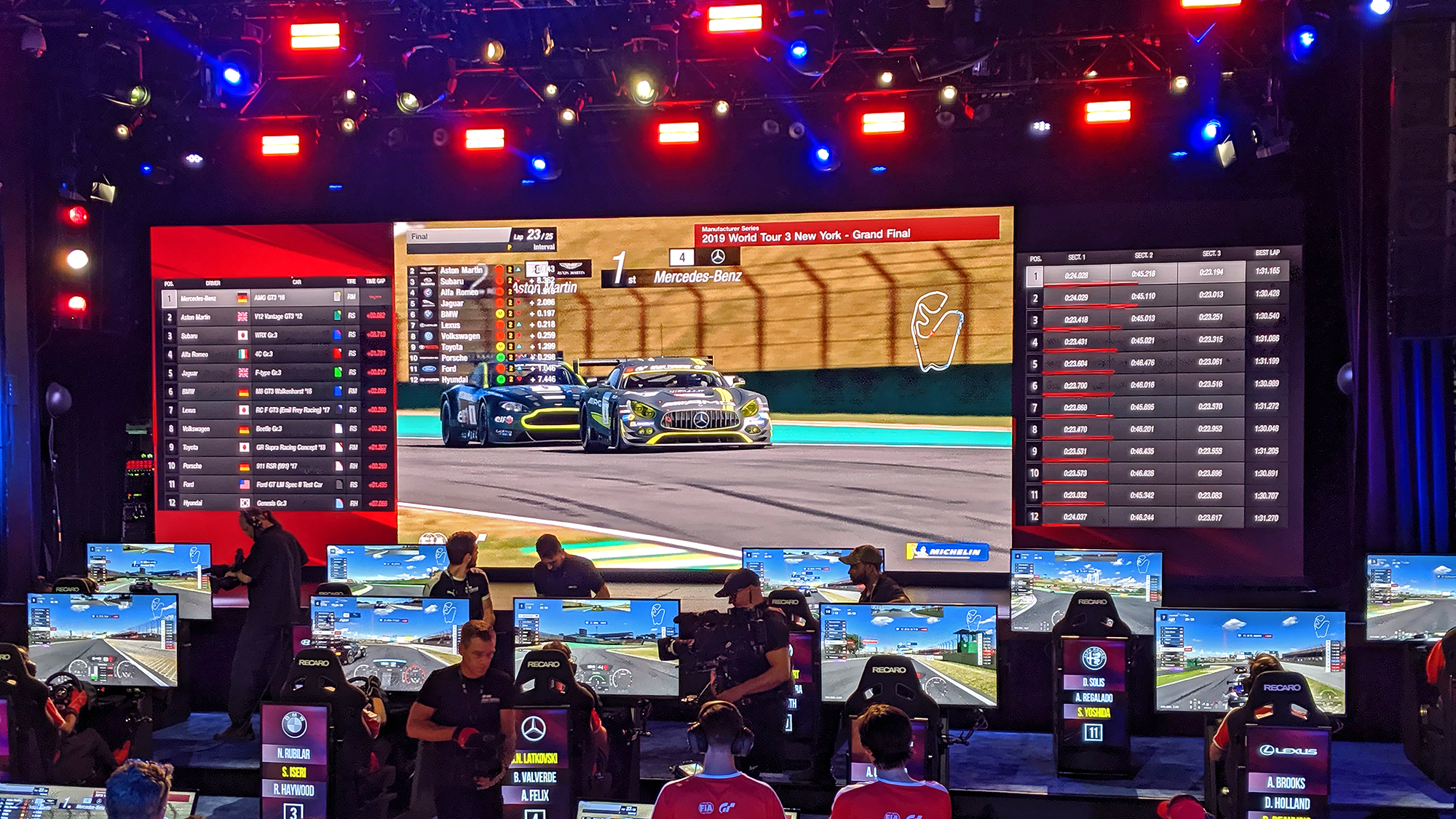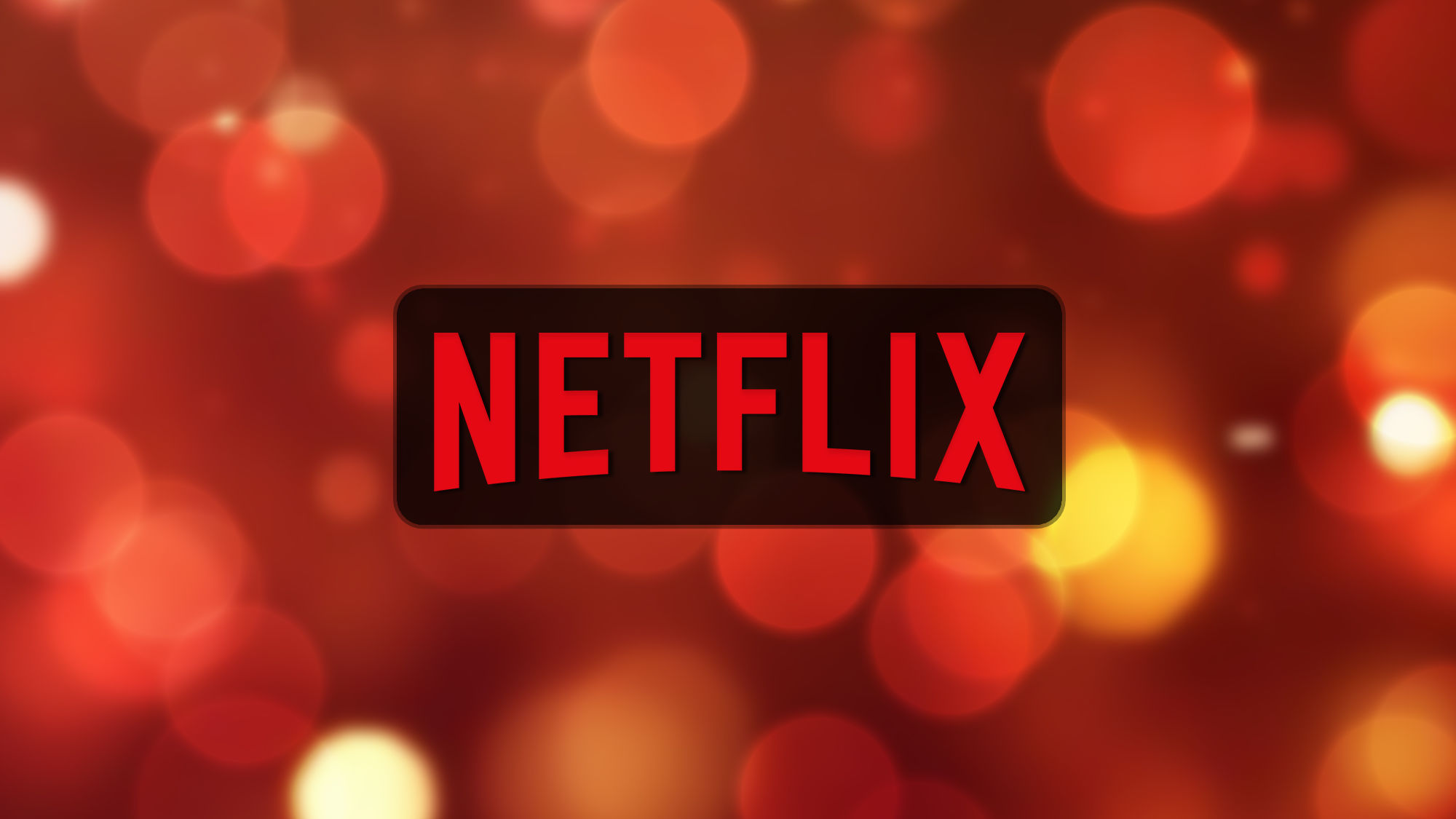How Sony's Massive Gran Turismo Championship Finally Sold Me on Esports
Blurring the lines between real and fake, in the best way possible

NEW YORK — The checkered flag had already waved on the New York round of Gran Turismo Sport's Nations Cup Final. The trophies were awarded, the victor's national anthem played, and the floor of Times Square's PlayStation Theater was dusted with confetti, as were most of the competitors themselves.
That's when the real drama started.
The winner, Brazillian driver and reigning series champion Igor Fraga, was offering his perspective on some on-track contact between himself and second-place finisher, German Mikail Hizal, who sat to Fraga's right.
Fraga gave fairly diplomatic answers to the interviewer, and all the while, Hizal smirked and rolled his eyes in exasperation and the audience maintained a quiet chatter. It was the kind of chatter you hear in a room where everyone knows they ought to be quiet but more and more people decide not to be.
Then, the questioning turned to Hizal, and the chatter silenced at once.
"I want to let you guys know something," Hizal said, looking to the audience. "I'm always trying to race as clean as possible, like not trying to win something by a dirty move, or something like that."
Hizal went on to describe his view of Fraga's controversial defensive maneuvers on the track, as spectators sat with their hands covering their mouths, wondering what he'd say next.
Get instant access to breaking news, the hottest reviews, great deals and helpful tips.
Fraga had been given a 5-second penalty for lifting off the throttle to trip up his rival in the middle of the track's fastest corner, when Hizal was following closely. Yet the penalty didn't change the finishing order, and Hizal made it clear he felt 5 seconds was much too lenient a punishment for a dangerous act that might earn you a race ban in the real world.
The outspoken German ended his account with a comment that elicited the biggest wave of "oohs" yet from the modest, albeit passionate New York crowd.
"If this championship is any more biased, I don't know."
I can't speak to what the rest of the audience thought when Hizal said those words, but I experienced a massive case of déjà vu. The exchange recalled Lewis Hamilton and Nico Rosberg lobbing passive-aggressive insults at each other during a tense post-race interview. Suddenly, the fact that it had all happened in the context of a video game couldn't have mattered less.
Get in the simulator
I've been playing Gran Turismo for nearly my entire life. Yet nothing could have prepared me for the spectacle of this World Tour event, from the slick production values to the drivers' skill and professionalism.
Roughly 40 of the best players in the world attended this New York round. To qualify, they had to finish highly in Manufacturer Series and Nations Cup online events that are available to all GT Sport players around the world. The tour stops five other spots besides New York, and the last one, in Monaco in November, represents the World Finals: a playoff between the winners of previous events, to crown the fastest driver and manufacturer team in the world.
"There would be some Saturdays I'd wake up, have lunch and then just sit on PlayStation until 10 at night."
Adam Suswillo, Competitor
To those that have never competed at such a high level, the prospect of knocking off tens of thousands of other players just to earn a shot at the World Tour might seem daunting enough. The real challenge, though, is staying on top.
"To actually qualify for this event, I put way too many hours in," said 27-year-old Englishman Adam Suswillo, who competes in both the Nations Cup and on behalf of Aston Martin in the Manufacturer Series.
"There would be some Saturdays I'd wake up, have lunch and then just sit on PlayStation until 10 at night. And that was just to get enough points for Aston Martin to get us into the top 12 to qualify."

Suswillo said he averages a couple of hours a day practicing when he's not at his day job, where he works in finance. Sony currently doesn't pay GT Sport competitors, though the winners of the Manufacturer and Nations championships get trophies, TAG Heuer watches and invitations to the FIA (Fédération Internationale de l'Automobile) prize-giving ceremony at the end of the year. There, they're honored alongside champions of established motorsports, like Formula 1 and the World Rally Championship. (For what it's worth, Formula 1 promotes an esports series of its own, which distributes a $500,000 prize fund among winners.)
Some competitors are up-and-coming real-life racing drivers in their own right. Fraga, for example, competes in Formula 3, a junior category of open-wheel racing, behind Formula 2 and Formula 1. And others who have been at it a bit longer, like Suswillo, are veterans of an earlier program, called GT Academy, that aimed to transform the best Gran Turismo players in the world into professional racers for Nissan.
Practice regimens like Suswillo's are not at all unique among the roster; in fact, they're the norm. The final round of the Manufacturer Series phase of the New York event saw Suswillo's Aston Martin bearing down the Mercedes-Benz of Australian Cody Nikola Latkovski. Suswillo had fresher, grippier tires, but Latkovski's airtight defense of the lead earned the Silver Arrows team the win.
It was quite the payoff, helping justify how much time the Aussie poured into honing his race craft in the run-up to the festivities.
"For these three races — the qualifying and the final race itself — myself, I spent 40 hours getting ready." Latkovski told Tom's Guide. "And we only got notified like four days before the event, so it's almost like 10 hours a day."
Latkovski, 18, is currently in university studying mechanical engineering. That's certainly a suitable career choice for a racer, and he said he still "always tries to find a little time in the day for Gran Turismo."
A team effort
He's not alone. In preparing for an event, especially in GT Sport's team-focused Manufacturer Series, Latkvoski and Suswillo are ironing out race strategies with their teammates. In the headline endurance races, where double points are up for grabs, all three drivers must share seat time and switch during every pit stop. Proper planning is crucial.
"I was coordinating with my teammates, letting them know what laps I was doing, the fuel situation, what we would need to look out for at each race on each track, where all the overtaking opportunities were," Latkovski said. "[It's about] having all that synergy within the drivers, knowing what we need to do when we get here and actually doing it."
Take into account that these competitors all hail from different countries and sometimes don't meet in real life until hours before an event, and you can see how organized a team must be to win.

"Really, the closest we can get is chatting through social media," Latkovski told me. "We didn't have the opportunity to meet in real life before coming. [Mercedes teammate] Bernal [Valverde], I saw him in the last World Tour, but since then, we had a different driver — now we have Anthony Felix — and we brought him in on WhatsApp. We started talking to him and getting him introduced to how everything works around here, and soon enough, he got used to it.
"We were communicating regularly, and by the time we got to New York, we were all on the same level. We all knew everything we needed to know about each other," Latkovski added.
During the Manufacturer events, drivers and their teammates monitoring the action all wear headsets. Those not in the car serve as strategists, processing the action much like the support crew in actual motorsports, sitting along the pit wall. They relay insights to the driver over the radio. In fact, during especially dramatic moments, the livestream will tap into team audio so the whole audience can hear — another delightful similarity to the real thing.
Also like real life, some drivers would just rather not be bothered with those distractions and prefer to keep on racing.
"I'm quite good at keeping track of everything myself," Suswillo said. "[Aston Martin teammate] Nick [McMillen] definitely asks more questions. I kind of just tend to knuckle-down like, 'OK, I know what I'm doing. I know how much fuel I've got,' and just go for it. And Nick was like, 'OK, save fuel,' and I was like, 'No, I'm going for it!'"
Getting everyone talking
These days, I spend much more of my time pretending to drive cars than actually driving them. So I could go on for ages about how surreal it was to hear Gran Turismo menu music piped into a theater and how phenomenal GT Sport looked on that big screen. In fact, everything ran so smoothly, and the experience was so captivating from a technological standpoint, that I wondered if I was watching GT Sport running on preliminary PlayStation 5 hardware. (I was told I was not, though you can never be sure.)
The thing is, none of that matters, because we're dealing with a sport now. And sports are made by storylines.
The dedication of the drivers is real. So, too, is their passion. And the same can be said for the debates among the spectators. So what if the cars aren't?
In the Manufacturer Series, we saw rivals Mercedes-Benz and Aston Martin encounter each other on the track again and again. That multirace dogfight culminated in Latkovski and Suswillo's epic four-lap skirmish at Brazil's iconic Interlagos circuit.
And in the Nations Cup, we saw two of the best playing the game today — Fraga and Hizal — leave it all on the track. Emotions ran high, and there was even a dose of contentious officiating just for good measure. For what it's worth, a week after the incident, Hizal seemed to have put the episode behind him, saying he's looking forward to "another cool battle in the future" with Fraga.
Rumors spread that the event's organizers were none too pleased with the polarizing outcome. For better or worse, though, it got people discussing the event, debating whether Fraga's tactics or Hizal's response were sportsmanlike. It inspired fans to ask questions they never have before, about whether it's fair to judge actions that would be transgressive in a realistic space with a virtual lens.
And it sets up thrilling battles for the rest of the season, including at the next round, in Austria, on the weekend of Sept. 13.
Any successful sport, that inspires people to follow along and take sides, must get people talking.
The dedication of the drivers is real. So, too, is their passion. And the same can be said for the debates among the spectators. So what if the cars aren't?
Adam Ismail is a staff writer at Jalopnik and previously worked on Tom's Guide covering smartphones, car tech and gaming. His love for all things mobile began with the original Motorola Droid; since then he’s owned a variety of Android and iOS-powered handsets, refusing to stay loyal to one platform. His work has also appeared on Digital Trends and GTPlanet. When he’s not fiddling with the latest devices, he’s at an indie pop show, recording a podcast or playing Sega Dreamcast.
